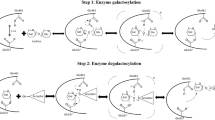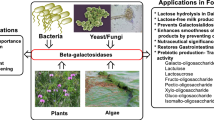Summary
Xylose reductase from the xylose-fermenting yeastPichia stipitis was purified to electrophoretic homogeneity via ion-exchange, gel and affinity chromatography. At physiological pH values the thermodynamic equilibrium constant was determined to be 0.575x1010 (l·mol-1). Product inhibiton studies are reported which clearly show that the kinetic mechanism of the xylose reductase is ordered-bi-bi with isomerisation of a stable enzyme form.
Similar content being viewed by others
References
Barnett JA (1976) Utilization of sugars by yeasts. Adv Carbohydr Chem Biochem 32:125–228
Bradford M (1976) A rapid and sensitive method for the quantitation of microgram quantities of protein utilizing the principle of protein dye binding. Anal Biochem 72:248–254
Bruinenberg PM, de Bot PHM, van Dijken JP, Scheffers WA (1984) NADH-linked aldose reductase: the key to anaerobic alcoholic fermention of xylose by yeasts. Appl Microbiol Biotechnol 19:256–260
Chiang C, Knight SG (1960a) Metabolism ofd-xylose by moulds. Nature 188:79–83
Chiang C, Knight SG (1960b) A new pathway of pentose metabolism. Biochem Biophys Res Comm 3:554–558
Cleland WW (1963a) Nomenclature and rate equations. Biochim Biophys Acta 67:104–137
Cleland WW (1963b) The kinetics of enzyme-catalyzed reactions with two or more substrates or products. 2. Inhibition: nomenclature and theory. Biochim Biophys Acta 67:173–187
Dalziel K (1957) Initial steady state velocities in the evaluation of enzyme-coenzyme-substrate reaction mechanisms. Acta Chem Scand 11:1706–1723
Dellweg H, Rizzi M, Methner H, Debus D (1984) Xylose fermentation by yeasts. 3. Comparison ofPachysolen tannophilus andPichia stipitis. Biotechnol Lett 6:395–400
Du Preez JC, van der Walt JP (1983) Fermentation ofd-xylose to ethanol by a strain ofCandida shehatae. Biotechnol Lett 5:357–362
Du Preez JC, Prior BA, Monteiro AMT (1984) The effect of aeration on xylose fermentation byCandida shehatae andPachysolen tannophilus. Appl Microbiol Biotechnol 19:261–266
Du Preez JC, Bosch M, Prior BA (1986) The fermentation of hexose and pentose sugars byCandida shehatae andPichia stipitis. Appl Microbiol Biotechnol 23:228–233
Horecker BL (1963) Pentose metabolism in bacteria. Wiley, New York, pp 100–111
Jeffries TW (1985) Effects of culture conditions on the fermentation of xylose to ethanol byCandida shehatae. Biotechnol Bioeng Symp 15:149–166
King EL, Altman C (1956) A schematic method of deriving the rate laws for enzyme catalyzed reactions. J Phys Chem 60:1375–1378
Laemmli UK, Favre M (1973) Maturation of the head of bacteriophage T4. I. DNA packaging events. J Mol Biol 80:575–599
Maurer Hr (1968) Disk-Elektrophorese. Verlag Walter de Gruyter, Berlin
Rizzi M, Klein C, Schulze C, Bui-Thanh NA, Dellweg H (1987) Mathematical model for the semiaerobic fermentation of xylose by the yeastPichia stipitis. In: Neijssel OM, van der Meer RR, Luyben KChAM. Elsevier, Amsterdam, NL, Vol 3:415
Rizzi M (1988) Biochemische und reaktionskinetische Charakterisierung der Xylose-Reduktase und der NAD+-Xylit-Dehydrogenase, isoliert ausPichia stipitis. Doctoral thesis, TU Berlin D83
Schneider H, Wang PY, Chan YK, Maleszka R (1981) Conversion ofd-xylose into ethanol by the yeastPachysolen tannophilus. Biotechnol Lett 3:89–92
Magee RJ, Kosaric N (1985) Bioconversion of hemicellulosics. Adv Biotechnol Bioengin 32:61–93
Segal HL, Kachmar JF, Boyer PD (1952) Kinetic analysis of enzyme reactions. Enzymologia 15:187–198
slininger PJ, Bothast RJ, van Cauwenberge JE (1982) Conversion ofd-xylose to ethanol by the yeastPachysolen tannophilus. Biotechnol Bioeng 24:371–384
Slininger PJ, Bothast RJ, Okos MR, Ladisch MR (1985) Comparative evaluation of ehanol production by xylose-fermenting yeasts presented high xylose concentrations. Biotechnol Lett 7:431–436
Sreenath HK, Chapman TW, Jeffries TW (1986) Ethanol production fromd-xylose in batch fermentations withCandida shehatae: process variables. Appl Microbiol Biotechnol 24:294–299
Toivola A, Yarrow D, van den Bosch E, van Dijken JP, Scheffers WA (1984) Alcoholic fermentation ofd-xylose by yeasts. Appl Environ Microbiol 47:1221–1223
Verduyn C, van Kleef R, Frank J, Schreuder H, van Dijken JP, Scheffers WA (1985) Properties of the NAD(P)H-dependent xylose reductase from xylose fermenting yeastPichia stipitis. Biochem J 226:669–677
Wilkinson GN (1961) Statistical estimations in enzyme kinetics. Biochem J 80:324–332
Author information
Authors and Affiliations
Rights and permissions
About this article
Cite this article
Rizzi, M., Erlemann, P., Bui-Thanh, NA. et al. Xylose fermentation by yeasts. Appl Microbiol Biotechnol 29, 148–154 (1988). https://doi.org/10.1007/BF00939299
Received:
Accepted:
Issue Date:
DOI: https://doi.org/10.1007/BF00939299




